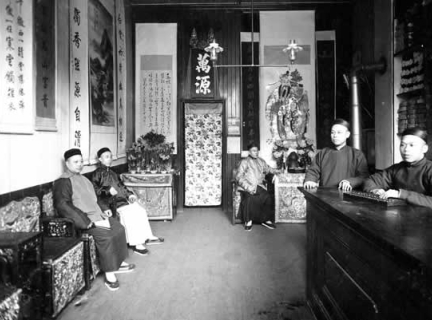Traditions and Characteristics

Name Order
-
Chinese names traditionally consist of three parts: the Clan Name, and two given names. The Clan Name (surname) appears first. Thus Yip Sang, a prominent Chinese Canadian pioneer, would have been "Mr. Yip", since Yip was his surname.
Given Names
-
One of the two given names was a "generation name". The generation name was usually, though not always, shared by all male or all female siblings of the same generation. The other was a personal name. For example, in the Wong family, two brothers share the given name, You. Each also has a unique given name, i.e.
Wong You Wah Wong You Rong Their two sisters also share a common given name, Yu, which differs from the common name shared by their brothers, i.e.
Wong Yu Ku Wong Yu Huan -
While people of British and European ancestry typically have one or two given names, a Chinese man traditionally had several different given names throughout life. These might include a milk (baby) name, school name, marriage name, and perhaps others.
-
Chinese women had fewer names, and essentially lost their given names at marriage, after which their names were commonly written as their maiden surnames, followed by Shih, Shee, or See, for example, Wong Shee, meaning "a married woman who came from the Wong clan."
-
Given Names were often not well-known and used even within a person's immediate circle and community. Kinship names were often used instead, for example: Grandmother, Third Uncle, Second Sister, etc.
Surnames
-
Surnames remained the same throughout life. However, dialectical and romanization differences affected the way in which the same name was pronounced. For example, a surname pronounced Chun in the Punti dialect might be Ching in the Hakka dialect, and Chen in its romanized form. All had the same written form and were in fact the same name. Therefore, it is very important to determine the written form of your Chinese surname. Even the written form of the name might vary, however, as there was no standardized national written form of Chinese until 1919, when Vernacular Chinese was adopted.
-
In some cases, the same written surname had different pronunciations which did not represent variant forms of a common surname, but rather reflected different genealogical traditions.
-
Conversely, some surnames with the same pronunciation had different written forms. Therefore, when a Chinese person introduced himself to another person, he would refer to the strokes or to a unique feature of the written character in order to indicate his correct surname.
-
Surnames sometimes changed for various reasons. For example, during wartime, part of the surname might be dropped in order to make it more difficult to identify distinct individuals or families.
-
Only about 2000 Chinese surnames are in use today, most of which occur rarely. Chinese people therefore share a very small number of surnames. This makes it more difficult to identify individuals and families with which you are directly connected.
